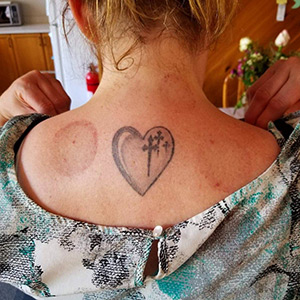CUPPING THERAPY. It comes with a note for your spouse!
You’ve probably seen people walking around looking like they got attacked by a giant octopus, with circular bruises (hickeys) on their shoulders, or neck, or lower back. This sight is becoming increasingly common. If you ask these people about their bruises they will tell you they have had cupping therapy. So what is cupping therapy?
Cupping therapy uses suction to effect the muscles and connective tissue. The suction is a great way to free up adhered connective tissue which can help improve range of motion and decreased pain associated with these adhesions. It also helps to loosen up tense muscles and can improve range of motion, decrease pain, and improve circulation. The therapist will often use cupping when they feel that it will be faster and more effective than using their hands. Cupping can apply greater force with less effort so your therapist can utilize their effort and your time more effectively to achieve greater results. By affecting the range of motion of a joint and decreasing pain, cupping can be very useful in helping you get back to the activities you love in a reasonable amount of time.
The big question about cupping is always why do those red marks appear? Cupping often leaves marks that can look very similar to a bruise. These marks should NOT feel like a bruise. They look worse than they are! The idea behind why this bruising happens has to do with injury. Injured areas will appear much darker than uninjured areas. For example if you have work done on a healthy shoulder you may not see any residual marks, but work on a shoulder that has been injured in the past may leave dark marks over the previously injured muscles. Traditionally the thought is that the suction is pulling stagnant blood that was stuck in the muscle up to the surface. If you consider that injury and overworking of a muscle can cause micro-tearing within the muscle this idea does not seem entirely unlikely. This would also explain why previously injured areas react so strongly and uninjured areas do not.
 As you can see in the photo, some spots reacted stronger than others with the same amount of pressure. There were four cups used here but only three really left marks. This patient is right handed and typically has a slight head tilt to the right, which means the right side of the neck would be getting used more heavily. She also experiences pain mostly on the right side. When you consider these things, the patterning of the upper two cups makes sense.
As you can see in the photo, some spots reacted stronger than others with the same amount of pressure. There were four cups used here but only three really left marks. This patient is right handed and typically has a slight head tilt to the right, which means the right side of the neck would be getting used more heavily. She also experiences pain mostly on the right side. When you consider these things, the patterning of the upper two cups makes sense.
Although the exact science around cupping is not fully developed at this point, its ability to improve range of motion and help with pain management is consistent when done correctly. Personally, I find its use for range of motion to have the most significant outcomes but it can be quite helpful when muscles become excessively tight and painful. Of course, as with any therapy, each person may react differently.
If you have any questions about cupping or are interested in booking an appointment please contact our office at (905) 841-0400 or by email at bobbi_jo@elevatechiropractic.ca. You can also book online here.
